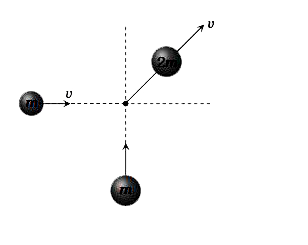A particle of mass m moving eastward with a speed v collides with another particle of the same mass moving northward coalesce on collision. The new particle of mass 2m will move in the north - easterly direction with a velocity
v/2
2v
v/√2
v
The correct Answer is:C
m1v1ˆi+m2v2ˆj=2m.v3
⇒mvˆi+m2v2ˆj=2m.v3
⇒mvˆi+mvˆj=2mv3
⇒v√2=2v3
⇒v3=v√2

Similar Questions
A particle of mass 'm' is moving with speed '2v' and collides with a mass '2m' moving with speed 'v' in the same direction. After collision, the first mass is stopped completely while the second one splits into two particles each of mass 'm' which move at angle 45∘ with respect to the original direction. The speed of each of the moving particle will be
View SolutionA particle of mass m moving with speed V collides elastically with another particle of mass 2m. Find speed of smaller mass after head on collision
View SolutionA particle of mass m moving with velocity v collides with a stationary particle of mass 2m, makinginelastic collision. The speed of the system after collision, will be
View SolutionA particle of mass m moving with velocity 2v collides with another particle of mass 3 m moving with velocity v in the same direction. If it is perfect inelastic collision, the loss of K.E. of the system is
View SolutionA particle of mass m moving with velocity 2v collides with another particle of mass 3m moving with velocity v in the same direction. If it is perfect inelastic collision, the loss of K.E. of the system is
View SolutionA particle of mass m moving with velocity v is collide with a stationary particle of mass 2 m . The speed of the system , after collision will be ……….
View SolutionA particle of mass m moving eastward with a velocity V collides with another particle of same mass moving northwards with the same speed V. The two particles coalesce and the new particle moves in NE direction. Calculate magnitude and direction of velocity of new particle.
View SolutionA particle of mass m moving with velocity 2v collides with another particle of mass 3m moving with velocity v in the same direction. If it is perfect inelastic collision, the loss of K.E. of the system is
View Solution
